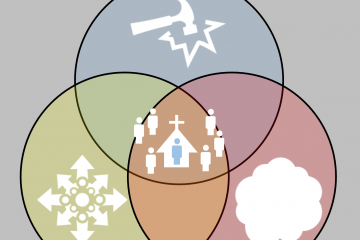I’ve been thinking quite a lot about the problem of defining collaborative ministry. It seems to me, that there is a tendency for people to use different terms to talk about the same thing – or use the same language in very different ways.
‘Collaboration’ basically means ‘working with’ and ‘ministry’ means service. This much is fairly straightforward. The problem is that people seem to have some radically different ideas about how they might ‘serve God together’…
This observation has led me to wonder if the way forward might be less of a case of ‘definition’ so much as ‘classification’. In other words, we might not be able to define collaborative ministry, but we might be able to give a range of models that help us to understand what a collaborative approach to ministry might look like.
Shared Action and Decision-Making
All models of collaborative ministry basically involve a combination of different approaches to shared action and/or decision-making. For example, one group may make decisions together by consensus and then work together to make them happen. Another group, however, may have a single ‘team leader’ who delegates tasks to team members. Both groups could describe themselves as ‘collaborative’ but they may struggle to recognise ‘collaboration’ in the other…
Decision-Making
Three basic approaches to decision-making in collaborative ministry are:
1. Managerial: A single leader or leadership team make decisions on behalf of the entire group.
2. Democratic: The whole group share in decision-making and take a vote when necessary. In some cases, the majority have authority over the minority.
3. Consensual: All decisions require the whole group to be happy. There may be occasions when a minority disagree with the majority view, but they effectively have a veto.
Put more bluntly, these approaches could be defined as ‘minority rules’, ‘majority rules’ and ‘minority vetoes’.
Action-Taking
Once decisions have been made, the resulting action can be carried out in three basic ways:
1. Delegated: Different individuals are given different tasks to carry out.
2. Organic: Different individuals develop different roles over time.
3. Equivalent: Everyone in the group does any or all of the tasks needed as the occasion demands.
Classifying Collaborative Ministry
If these three approaches to action are mapped in a grid against the three approaches to decision-making, we end up with a grid with nine categories, ranging from managerial-delegated to consensual-equivalent.

I would like to suggest that all nine models are forms of collaborative ministry, but some may be more appropriate in particular contexts. For example, it might be better to run a church magazine using a democratic-delegated model, while a ministry team might operate better using a consensual-equivalent model.
The point I am basically making is that those who seek to ‘do’ collaborative ministry, in whatever context, may be wise to decide, at an early stage, exactly what they mean when they use the phrase. Otherwise a great deal of confusion and conflict may well be inevitable.


